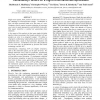Free Online Productivity Tools
i2Speak
i2Symbol
i2OCR
iTex2Img
iWeb2Print
iWeb2Shot
i2Type
iPdf2Split
iPdf2Merge
i2Bopomofo
i2Arabic
i2Style
i2Image
i2PDF
iLatex2Rtf
Sci2ools
126
Voted
MICRO
2003
IEEE
2003
IEEE
A Systematic Methodology to Compute the Architectural Vulnerability Factors for a High-Performance Microprocessor
Single-event upsets from particle strikes have become a key challenge in microprocessor design. Techniques to deal with these transient faults exist, but come at a cost. Designers clearly require accurate estimates of processor error rates to make appropriate cost/reliability trade-offs. This paper describes a method for generating these estimates. A key aspect of this analysis is that some single-bit faults (such as those occurring in the branch predictor) will not produce an error in a program's output. We define a structure's architectural vulnerability factor (AVF) as the probability that a fault in that particular structure will result in an error. A structure's error rate is the product of its raw error rate, as determined by process and circuit technology, and the AVF. Unfortunately, computing AVFs of complex structures, such as the instruction queue, can be quite involved. We identify numerous cases, such as prefetches, dynamically dead code, and wrong-path inst...
| Added | 05 Jul 2010 |
| Updated | 05 Jul 2010 |
| Type | Conference |
| Year | 2003 |
| Where | MICRO |
| Authors | Shubhendu S. Mukherjee, Christopher T. Weaver, Joel S. Emer, Steven K. Reinhardt, Todd M. Austin |
Comments (0)

